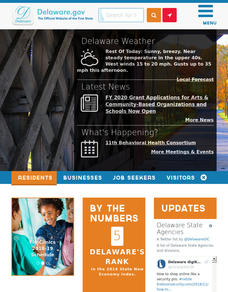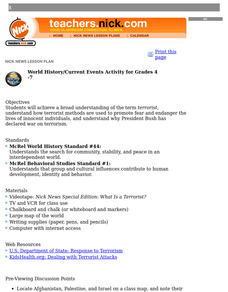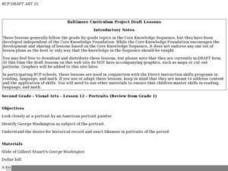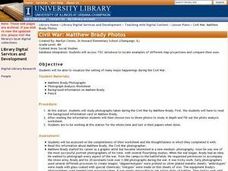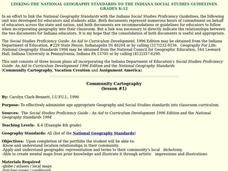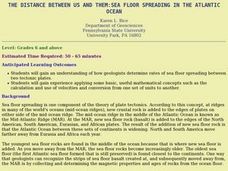Curated OER
The Constitution
Students use both electronic and traditional resources to research information about U.S. Constitution, answer questions pertaining to Congress and the Presidency, and design HyperStudio presentation to display answers to research...
Curated OER
Slavery and the Underground Railroad
Fourth graders examine the experiences of the slaves on the Underground Railroad. They analyze maps depicting slaves' routes, calculate the mileage travelled, and write an essay and create an illustration about the Underground Railroad.
Curated OER
Give Me The C and D Canal!!!
Students estimate the distance from Baltimore to Philadelphia via the water route before the Chesapeake and Delaware Canal was built. Students study canals and how transportation and economic necessities dictate the building of a canal.
Curated OER
U.S. Place Names Show Our Diversity
Students study place names for different area in the US and determine why they were named in such a way. They examine maps to look at the religious names, "new" beginning names, and copy cat names. They complete a word search to find...
Curated OER
Predicting the Past
Students study how archaeologists record the past. They discuss archaeology and artifacts. They view a list of artifacts discovered by Marquette at the Illinois Village and answer questions regarding them. They complete a test about...
Curated OER
Comparing Northwest Native American Communities
Students review how to use the database from previous lessons. Using the information, they identify the historical and environmental effects on the people living in the Pacific Northwest. They examine the various Native American groups...
Curated OER
World History/Current Events Activity
Students define the term terrorist, and examine how terrorist methods are used to promote fear and endanger the lives of innocent individuals. They analyze why President Bush has declared war on terrorism, and write essays on terrorism.
Curated OER
No magic borders
Students discuss what they have heard about pollution. They explore the purposes and limitations of political boundaries and borders and identify some of the causes and effects of pollution.
Curated OER
Sailing Through History
Learners research examples of different types of sailing ships, investigating the vessels as well as the politics, economy, and people at the historical time and place the boat was launched. They create displays for a museum exhibit...
Curated OER
Visual Arts: Portraits
Second graders examine a portrait of George Washington, and analyze the historical record and likeness in portraits of the period. They create their own portraits from snapshots brought to school.
Curated OER
Get Your Kicks on Route 66
Students research when and why Route 66 was started and how mom and pop businesses fit in with Route 66. Students associate what they've learned with the song.
Curated OER
Civil War: Matthew Brady Photos
Fourth graders read background information on Matthew Brady and examine photographs of the Civil War taken by him. They fill in worksheets based on their research.
Curated OER
Philadelphia's Important Contribution to the Lewis and Clark Expedition
Students analyze a primary source document (Jefferson's secret letter to Congress) and identify its objectives through the aid of focus questions. They complete a graphic organizer and write an article summarizing Philadelphia's...
Curated OER
Rights Under the Fourth Amendment
Twelfth graders examine the Fourth Amendment and discuss an actual Supreme court case. They determine whether or not the person's rights were violated. they search newspapers for articles where the Fourth Amendment may have been violated
Curated OER
Lesson Plan on Important Citizens in the American Civil War
Students, in groups, half representing the Confederacy, half the Union, conduct research to find out about important Civil War era citizens from each side. They explore the effect these people had on the war and what effect the war had...
Curated OER
Lesson Plan on Military Leaders in the American Civil War
Young scholars, in groups, half representing the Confederacy, half the Union, conduct research to find out about important Civil War military leaders from each side. They find the answers to a variety of questions regarding their...
Curated OER
TE Activity: The Trouble with Topos
Young scholars study the uses of topographical maps including the many forms that they take. They discover that the map features show its intended use such as city maps, wilderness maps, and state maps. They complete a worksheet in which...
Curated OER
Where In the World Are We?
Fifth graders read postcards and find their locations on maps. They use the pictures and text on the postcards to write about imaginary vacations. They compute the mileage and compare it to TripMaker data.
Curated OER
Comprehension
Fifth graders take part in a panel discussion. In this character lesson students show their understanding of the connection between events in a story and the development of characters. Students provide evidence from the story to support...
Curated OER
Volcanoes In Japan
Sixth graders study the characteristics of volcanoes in this unit. They apply the research to the study of three volcanoes in Japan. They complete mapwork, identify indicators of impending volcanic activity, and describe the dangers...
Curated OER
Texas
Students draw the outline of the Lone Star State, label the state signs (bird, flower, tree), and sing the state song.
Curated OER
The Seminoles
Young scholars explore the Southeast Woodland region and culture of the Seminole Indians using video, art projects, books, maps and discussion.
Curated OER
Community Cartography
Students use an inflatable globe which they wrap in plastic wrap. They use a permanent marker and outline the continents, and label major oceans and trace the equator. Students bring heir globes and use their projection for a discussion...
Curated OER
The Distance Between Us and Them: Sea Floor Spreading in the Atlantic Ocean
Students examine how geologists determine rates of sea floor spreading between two tectonic plates. They apply mathematical concepts such as the calculation and use of velocities and conversion from one set of units to another.




